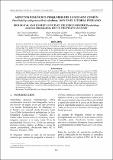Por favor, use este identificador para citar o enlazar este ítem:
https://hdl.handle.net/20.500.12958/3651Registro completo de metadatos
| Campo DC | Valor | Lengua/Idioma |
|---|---|---|
| dc.contributor.author | Tacuri Santisteban, Paul | - |
| dc.contributor.author | Argumedo Guillén, Edgar | - |
| dc.contributor.author | Pérez Huaripata, Miguel | - |
| dc.contributor.author | Castillo Mendoza, Gladis | - |
| dc.contributor.author | Saldarriaga Mendoza, Maritza | - |
| dc.contributor.author | Lau Medrano, Luis | - |
| dc.contributor.author | Palacios León, Jacqueline | - |
| dc.contributor.author | Guevara Carrasco, Renato | - |
| dc.date.accessioned | 2021-12-09T19:01:54Z | - |
| dc.date.available | 2021-12-09T19:01:54Z | - |
| dc.date.issued | 2021-12 | - |
| dc.identifier.citation | Tacuri P, Argumedo E, Pérez M, Castillo G, Saldarriaga M, Lau L, Palacios J, Guevara-Carrasco R. 2021. Aspectos biológico-pesqueros del lenguado común Paralichthys adspersus (Steindachner, 1867) en el litoral peruano. Inf Inst Mar Perú. 48(4): 552-562 | es_ES |
| dc.identifier.issn | 0378-7702 | - |
| dc.identifier.uri | https://hdl.handle.net/20.500.12958/3651 | - |
| dc.description.abstract | Se determinaron algunos aspectos de la biología y pesquería del lenguado común, Paralichthys adspersus, recolectados de los desembarques de la pesca artesanal en el litoral peruano durante 1950-2018. Los mayores desembarques de lenguado se registraron en regiones ubicadas en la zona norte-centro del litoral peruano (Lambayeque, La Libertad, Áncash, Lima e Ica con 92%), y con redes de pesca o cortina agallera (43%) y de trasmallo (24%). Se determinó el índice gonadosomático (IGS) que mostró el valor más alto de su ciclo reproductivo en octubre para las localidades de Chimbote e Ilo; la talla de primera madurez gonadal (TPM) de lenguado fue de ~33 cm LT. Estos resultados constituyen un aporte a las bases científicas para la ordenación pesquera del lenguado en el Perú. | es_ES |
| dc.description.abstract | ABSTRACT: Information from artisanal landings in the Peruvian coast between 1950-2018 was analyzed to determine some biological and fishery aspects of the fine flounder, Paralichthys adspersus. Its largest landings occurred in Lambayeque, La Libertad, Ancash, Lima, and Ica (amounting to 92%). and the most used fishing gears were the gillnet (43%) and trammel net (24%). In October, the gonadosomatic index (GSI) showed the highest value of its reproductive cycle in Chimbote and Ilo. The size at first maturity (Lm50) of the fine flounder was ~33 cm TL. These results provide a scientific basis for the fisheries management of the resource in Peru. | - |
| dc.language.iso | spa | es_ES |
| dc.publisher | Instituto del Mar del Perú | es_ES |
| dc.relation.ispartofseries | Informe IMARPE 48(4), 2021; | - |
| dc.rights | info:eu-repo/semantics/openAccess | es_ES |
| dc.rights.uri | https://creativecommons.org/licenses/by/4.0/ | es_ES |
| dc.source | Instituto del Mar del Perú - IMARPE | es_ES |
| dc.source.uri | Repositorio Digital IMARPE | es_ES |
| dc.subject | Paralichthys adspersus | es_ES |
| dc.subject | Lenguado común | es_ES |
| dc.subject | Biologia | es_ES |
| dc.subject | Talla | es_ES |
| dc.subject | Pesquería | es_ES |
| dc.subject | Mar peruano | es_ES |
| dc.title | Aspectos biológico-pesqueros del lenguado común Paralichthys adspersus (Steindachner, 1867) en el litoral peruano | es_ES |
| dc.title.alternative | Biological and fishery aspects of the fine flounder Paralichthys adspersus (Steindachner, 1867) in the Peruvian coast | es_ES |
| dc.type | info:eu-repo/semantics/article | es_ES |
| dc.publisher.country | Perú | es_ES |
| dc.subject.ocde | http://purl.org/pe-repo/ocde/ford#1.06.12 | es_ES |
| Aparece en las colecciones: | Informe vol. 48(4) 2021 | |
Ficheros en este ítem:
| Fichero | Descripción | Tamaño | Formato | |
|---|---|---|---|---|
| Informe 48-4 articulo5.pdf | 4,22 MB | Adobe PDF |  Visualizar/Abrir |
Este ítem está sujeto a una licencia Creative Commons Licencia Creative Commons

